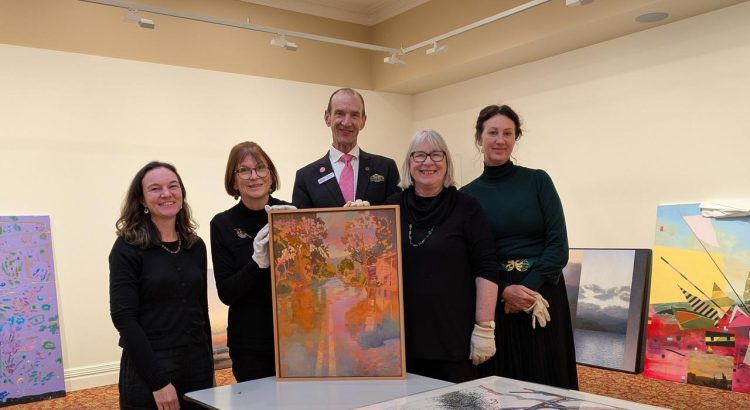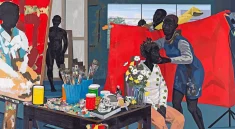Robert Draws – Victoria Peel captures the haunting beauty of disaster in her artwork titled The Road Less Travelled which recently won the Packing Room Prize at the prestigious Hadley Art Prize 2025. The painting was inspired by the devastating floods that struck the Hawkesbury region in 2022. With her canvas as a reflective medium Peel translated the trauma and emotional aftershocks of the natural disaster into a meditative and compelling visual. Her work is both an homage to nature and a commentary on its dual force of creation and destruction. The image portrays a flooded rural road surrounded by silent stillness yet echoing the chaos it has endured. This emotional tension gripped the judging panel and the viewers alike leading to her victory. The upcoming Hadley Art Prize main exhibition will be held in Tasmania from August 29 to September 21 2025 and will showcase the powerful voices of contemporary Australian landscape artists.
A Deeply Personal Vision Victoria Peel Paints Through Pain and Memory
The creation of The Road Less Travelled emerged from Victoria Peel’s need to process the traumatic memories following the 2022 floods. For days her home was isolated from communication and electricity. During this period her only form of release was through painting. With each brushstroke she confronted fear helplessness and the stunning quietness that follows destruction. Victoria Peel transformed what could have been despair into a meditative ritual allowing her to find calm within creative expression. Her decades of artistic experience helped her blend emotion with technique delivering a piece that resonates far beyond its visual appeal. The reflection of water light and nature mirrors the reflection within herself. In Tasmania where she now resides Peel reconnected with a supportive art community making this recognition feel like both a personal and professional homecoming. Her painting speaks not only for herself but also for many who have lived through natural calamity.
Tasmania Hosts the Hadley Art Prize and Showcases Emotional Landscapes
Held annually in Hobart the Hadley Art Prize is one of Australia’s most prestigious awards dedicated to landscape art. The main event will be held at the historic Hadleys Orient Hotel from late August through September 2025. Visitors can view selected works from talented artists including the award-winning piece by Victoria Peel. The Packing Room Prize includes a framing voucher and accommodation for finalists. While modest in financial terms the award carries significant prestige within the art world. Victoria Peel’s victory places her among celebrated artists who translate the Australian landscape into vivid emotional and visual expressions. The show invites audiences to witness the evolution of landscape painting from traditional vistas to works shaped by memory loss climate and survival. It becomes a space where natural beauty and human vulnerability coexist on canvas allowing deeper appreciation for both nature and artistic interpretation.
“Read more: PVC vs Fiberglass Garage Doors: Which One Will Transform Your Home?”
From Hawkesbury to Healing Victoria Peel Brings Nature and Trauma to Canvas
Victoria Peel’s artistic journey spans over four decades and her deep connection to the Australian landscape informs every piece she creates. The Road Less Travelled showcases a muddy road partially submerged reflecting the grey skies above. In subtle tones and minimalist structure she captures the suffocating stillness after a storm. Though the event it references occurred in 2022 the emotional weight remains visible in the painting’s depth. Peel studied fine arts in Sydney and taught for many years sharing her methods of using nature as a tool for reflection. This piece continues that tradition. While some might see only water and road others find grief anxiety and even peace layered within the imagery. Her ability to embed complex emotions into seemingly quiet visuals is what sets her apart. The Hadley jury and audiences acknowledged that power with well-deserved praise during the announcement of this year’s winners.
Art as Catharsis Victoria Peel’s Victory Resonates with a Broader Message
Victoria Peel’s work serves as a reminder that art can be both personal and universal. By confronting environmental trauma and personal loss she creates a visual language that resonates with anyone who has experienced disruption in life. Through this artwork a new conversation begins about climate change resilience and the role of memory in artistic expression. Rather than being overtly political the painting speaks softly yet firmly of what has been lost and what remains. It asks viewers to pause reflect and engage with both the beauty and fragility of the world around them. This is not merely a visual celebration but a symbolic healing. As Victoria Peel stands recognized on a national stage her story encourages emerging artists to trust their own narratives and emotions when facing the blank canvas. Her success proves that even in devastation beauty can be discovered.



